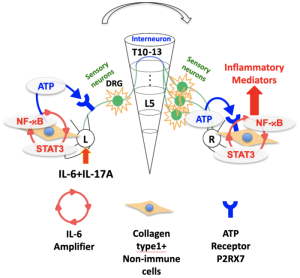Rheumatoid arthritis is a chronic inflammatory autoimmune disorder that primarily affects joints. One of the key features of this disease is remote inflammation, where inflammation spreads from one joint to another. Research has shown that neural circuits or cells migrated from the joints are involved in inflammation spread, but the detailed mechanism by which this occurs has not been fully understood.
Now, a team of researchers from Japan and Vanderbilt University in the U.S., led by Masaaki Murakami, PhD, at Hokkaido University, has shown that remote inflammation spreads by neuron crosstalk in a mouse model, and that adenosine triphosphate (ATP) plays a key role in this process. Their study “ATP spreads inflammation to other limbs through crosstalk between sensory neurons and interneurons,” published in the Journal of Experimental Medicine, may lead to new therapies for inflammatory diseases, according to the scientists.

“Neural circuits between lesions are one mechanism through which local inflammation spreads to remote positions. Here, we show the inflammatory signal on one side of the joint is spread to the other side via sensory neuron–interneuron crosstalk, with ATP at the core,” write the investigators.
“Surgical ablation or pharmacological inhibition of this neural pathway prevented inflammation development on the other side. Mechanistic analysis showed that ATP serves as both a neurotransmitter and an inflammation enhancer, thus acting as an intermediary between the local inflammation and neural pathway that induces inflammation on the other side.
“These results suggest blockade of this neural pathway, which is named the remote inflammation gateway reflex, may have therapeutic value for inflammatory diseases, particularly those, such as rheumatoid arthritis, in which inflammation spreads to remote positions.”
In this study, the authors used previous observations of the gateway reflex—an immune response mechanism whereby specific neural signals change the state of specific blood vessels to allow immune cells to enter tissue, leading to local inflammation—to hypothesize that neural crosstalk could be responsible for remote inflammation. They tested this hypothesis through experiments in rheumatoid arthritis models in mice.
The mice were divided into control and test groups. In the test groups, the sensory neural circuits between the left and right ankle joints were interrupted. Arthritis of the left ankle was then induced in both sets of mice and the spread of arthritis to the right ankle was observed.
Their results showed that the inflammation signal in one joint is transmitted to the other via a sensory neuron connection through the spinal cord, leading to inflammation in both joints. Specifically, inflammation in one joint led to an increase of ATP in both joints, which triggered an increase of a signal molecule that resulted in inflammation. Blocking this pathway prevented the spread of inflammation.
As this study was performed in mouse models, it is necessary to determine if the findings apply to rheumatoid arthritis and other chronic inflammatory diseases in humans, note the researchers. If so, it could provide a therapeutic target for various diseases with spreading inflammation.


